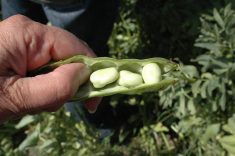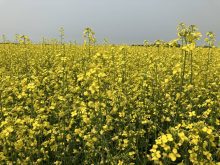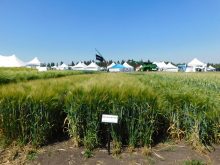When John Schneider got the urge to farm, he figured livestock would be a good fit for a small acreage but the economies of scale worked against him.
Then he discovered heritage grains.
“I think that’s the key to being successful in small agriculture — it’s just to create a niche for yourself and do something different,” said Schneider, who farms with wife Cindy and their two children on 400 acres near Morinville.
Schneider is a sixth-generation farmer who didn’t realize he wanted to farm until his father sold the land. So the construction industry executive bought some land, and in 2000 started farming on the side, trying his hand at sheep, pigs, pastured poultry and beef cattle. He started Gold Forest Grains in 2007, which allowed him to farm full time. He grows up to 10 crops at a time, and is currently growing spelt, rye and three heritage wheats: Park, Red Fife, and einkorn on his organic operation.
Read Also

New crop insurer policy enables easier startup for faba beans
Agriculture Financial Services Corporation updated its normals for faba beans, which may open the door for more Canadian producers to feel comfortable growing the pulse crop in the future.
Heritage varieties present numerous challenges — they take longer to mature (although Schneider said that’s not a problem as frost seem to come later these days), don’t do well under weed pressure, and grow taller, which makes them more susceptible to lodging (intercropping is used to combat this problem).
Spelt a challenge
But it’s spelt, which was grown by the ancient Romans, that really tests Schneider’s farming skills.
“We’ve done it for a couple of years and the seed germination is hard for us, so we’re working on that problem,” he said.
Spelt is a hulled grain, so it doesn’t go through a seed drill very easily.
“For some of these grains, you need to relearn how to deal with them,” he said.
Einkorn is low yielding, but quite rare and so commands a substantial premium. Park wheat, developed in Alberta and grown in the 1950s, is an early-maturing variety while Red Fife is prized, in part, because its taste varies yearly, reflecting both that season’s growing conditions and the local environment. Both are excellent for baking.
As an organic farmer, Schneider uses companion planting, crop rotations, intercropping, summerfallow, and green manure as management strategies.
But the key to the farm’s success has been on-farm processing.
“What we soon discovered was that we had to eliminate as many middle men as we could,” he said.
“Instead of selling a bushel of wheat for whatever it’s going for, six or seven dollars a bushel, we sell it for $113 a bushel. By the time we mill it into flour and sell it at the farmers’ market, it’s worth that much.”
The couple sell flours, cracked grain cereal and pancake mixes, as well as whole grain kernels for people who do their own milling. The grain is cleaned and bagged at the Morinville seed cleaning plant, placed in storage, and milled as needed using one of the couple’s three stone mills. They sell at the Old Strathcona and St. Albert farmers’ markets, as well as some Edmonton-area retailers.
Many of his customers are sensitive to gluten, said Schneider.
“We have many customers that come up to us and say, ‘I can’t eat wheat, but I can eat your wheat,’” he said. “There seems to be something to that.”
Schneider credits his farming blog, which he started in 2006, as another key to the farm’s success.
“I got lucky because social media became mainstream marketing,” he said. “When I started blogging, there was no such thing as social media. Some of it was luck and some of it was just hard work.”















